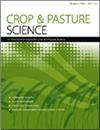Siphoning novel sources of seedling salinity tolerance from the diverse chickpea landraces
IF 1.9
4区 农林科学
Q2 AGRICULTURE, MULTIDISCIPLINARY
引用次数: 1
Abstract
ABSTRACT Context. Chickpea (Cicer arietinum L.) are highly sensitive to elevated salinity, particularly at initial seedling establishment stage. Seedling screening would be an effective means to identify novel sources of donors for salt tolerance. Aim.This study aimed to identify salt stress tolerant genotypes at seedling stage from 50 chickpea accessions. Methods. The screening of 50 chickpea accessions was done under two salinity conditions including salt stress (8 dS m−1) and control (no salt stress). Accessions were studied for morphological traits, root system architectural analysis, and CSTI (Cumulative salt tolerance index). Further, principal component analysis was conducted to validate these results for more accuracy and reliability. Key results. For morphological traits, a high degree of genetic variation was seen among genotypes, and root traits were found to be the better indicators of salt stress tolerance. CSTI was used to classify the accessions; 22 (44%) were identified as salt sensitive, 21 (42%) were found to be moderately salt tolerant, and 7 (14%) had moderate to high salt tolerance. The most salt tolerant and salt sensitive genotypes were found to be ICCV10 and ILC5595, respectively. Conclusions. Early seedling screening has a great potential to identify genotypes with robust root systems, which can withstand salinity. Implications. We used a novel approach to classify chickpea landraces based on the combination of CSTI and principal component analysis methods. By choosing suitable donors and prospective genotypes at early growth stages, the knowledge gathered from this study may aid scientists and chickpea breeders in developing salt tolerant cultivars.从鹰嘴豆地方品种中提取耐盐苗木新来源
抽象的上下文。鹰嘴豆(Cicer arietinum L.)对高盐度非常敏感,特别是在幼苗建立初期。苗木筛选将是鉴定耐盐供体新来源的有效手段。的目标。本研究旨在鉴定50份鹰嘴豆苗期耐盐基因型。方法。选取50份鹰嘴豆材料,在盐胁迫(8 dS m−1)和对照(无盐胁迫)两种盐胁迫条件下进行筛选。对材料进行了形态性状、根系结构分析和累积耐盐指数研究。进一步,进行主成分分析验证这些结果,以提高准确性和可靠性。关键的结果。在形态性状方面,基因型间存在较大的遗传变异,根系性状是耐盐性的较好指标。采用CSTI对资料进行分类;22株(44%)为盐敏感,21株(42%)为中等耐盐,7株(14%)为中高耐盐。ICCV10和ILC5595分别是耐盐性最强和盐敏感性最强的基因型。结论。早期幼苗筛选对于鉴定出具有耐盐根系的基因型具有很大的潜力。的影响。本文提出了一种基于CSTI和主成分分析相结合的鹰嘴豆地方品种分类方法。通过在生长早期选择合适的供体和预期的基因型,本研究收集的知识可能有助于科学家和鹰嘴豆育种者培育耐盐品种。
本文章由计算机程序翻译,如有差异,请以英文原文为准。
求助全文
约1分钟内获得全文
求助全文
来源期刊

Crop & Pasture Science
AGRICULTURE, MULTIDISCIPLINARY-
CiteScore
4.20
自引率
15.80%
发文量
111
审稿时长
3 months
期刊介绍:
Crop and Pasture Science (formerly known as Australian Journal of Agricultural Research) is an international journal publishing outcomes of strategic research in crop and pasture sciences and the sustainability of farming systems. The primary focus is broad-scale cereals, grain legumes, oilseeds and pastures. Articles are encouraged that advance understanding in plant-based agricultural systems through the use of well-defined and original aims designed to test a hypothesis, innovative and rigorous experimental design, and strong interpretation. The journal embraces experimental approaches from molecular level to whole systems, and the research must present novel findings and progress the science of agriculture.
Crop and Pasture Science is read by agricultural scientists and plant biologists, industry, administrators, policy-makers, and others with an interest in the challenges and opportunities facing world agricultural production.
Crop and Pasture Science is published with the endorsement of the Commonwealth Scientific and Industrial Research Organisation (CSIRO) and the Australian Academy of Science.
 求助内容:
求助内容: 应助结果提醒方式:
应助结果提醒方式:


